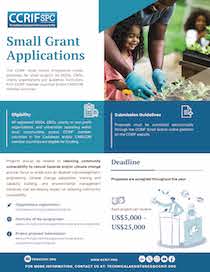16 September, 2010 – Today, the Caribbean Catastrophe Risk Insurance Facility (CCRIF) paid the Government of Anguilla US$4,282,733 following the passage of Tropical Cyclone Earl which passed close to the island on 30 August, 2010. This amount was due to the Government based on its catastrophe insurance policy for hurricanes which forms part of the country’s disaster risk management strategy. The value represents almost 20 times the annual premium of US$225,000 that the Government pays for hurricane coverage. Anguilla has been a member of CCRIF – and has had catastrophe insurance policies for earthquakes as well as hurricanes – since the inception of the Facility in 2007. The fifteen other Caribbean member countries joined Anguilla in renewing their CCRIF policies for the new policy year that began on 1 June, 2010.
Less than 24 hours after the hurricane passed Anguilla, CCRIF determined that a payout would be effected and indicated the approximate amount to the Government. The funds were transferred today, following the required 14-day waiting period during which the specific calculations were verified. CCRIF offers parametric insurance and therefore payouts can be calculated and made very quickly because there is no need to wait on loss adjusters to estimate damage after an event, which can take a long time. The payout determination was made based on government losses calculated using storm data from the National Hurricane Center and parameters fixed within the new second generation loss estimation model that is being used to underpin CCRIF’s policies starting this policy year. These parameters include the level of wind and ocean hazards encountered across the affected area and the value and distribution of government exposures to those hazards. In particular, as a low-lying island, Anguilla is impacted by coastal storm surge and wave damage, which have long- term detrimental impacts on the tourism-based economy.
CCRIF made early contact with key officials in Anguilla after the passage of Earl. Ms Kathleen Rogers, Permanent Secretary in the Ministry of Finance has indicated that the ~US$4 million will be used to capitalise a special recovery fund, expenditure from which will be controlled by a newly- convened committee to ensure transparency and sound fiscal control. Upon receiving confirmation that payment would be made, Ms Elizabeth Klute, Director of Anguilla’s Department of Disaster Management, said the Government was “very grateful for the support of both CCRIF and the Caribbean Institute for Meteorology and Hydrology (CIMH).”
Since the passage of the hurricane, CCRIF has been supporting the CIMH in its work with the Ministry of Finance, local disaster management officials and others in Anguilla to analyse the impacts and gather on-the-ground information to better understand the hazards and damage in order to improve overall planning for and response to hurricane events in the region.
Actual damage included some major roof loss, as well as flooding of government and other buildings. Power lines were downed across the island, and coastal damage was significant, including many beached vessels and beach erosion. Prior preparation for Earl’s passage, supported by real-time storm impact forecasts from the CCRIF-supplied Real-Time Forecasting System (RTFS), clearly had an impact on reducing damage levels and also helped to prevent loss of life during the storm.
This is the second payout made by CCRIF in 2010; the Facility made a payment to the Government of Haiti following the devastating earthquake that occurred in January and continues to provide assistance to that country in the post-disaster recovery period. In addition to providing catastrophe insurance to Caribbean governments, CCRIF will continue to serve the region through technical assistance and the development of new disaster risk management tools.
About CCRIF: CCRIF is a risk pooling facility, owned, operated and registered in the Caribbean for Caribbean governments. It is designed to limit the financial impact of catastrophic hurricanes and earthquakes to Caribbean governments by quickly providing short term liquidity when a policy is triggered. It is the world’s first and, to date, only regional fund utilising parametric insurance, giving Caribbean governments the unique opportunity to purchase earthquake and hurricane catastrophe coverage with lowest-possible pricing. CCRIF represents a paradigm shift in the way governments treat risk, with Caribbean governments leading the way in pre-disaster planning.
CCRIF was developed through funding from the Japanese Government, and was capitalised through contributions to a multi-donor Trust Fund by the Government of Canada, the European Union, the World Bank, the governments of the UK and France, the Caribbean Development Bank and the governments of Ireland and Bermuda, as well as through membership fees paid by participating governments.
Sixteen governments are members of the fund: Anguilla, Antigua & Barbuda, Bahamas, Barbados, Belize, Bermuda, Cayman Islands, Dominica, Grenada, Haiti, Jamaica, St. Kitts & Nevis, St. Lucia, St. Vincent & the Grenadines, Trinidad & Tobago and the Turks and Caicos Islands.
For more information, contact Simon Young at syoung@caribrm.com, CCRIF at pr@ccrif.org or visit the website at www.ccrif.org





